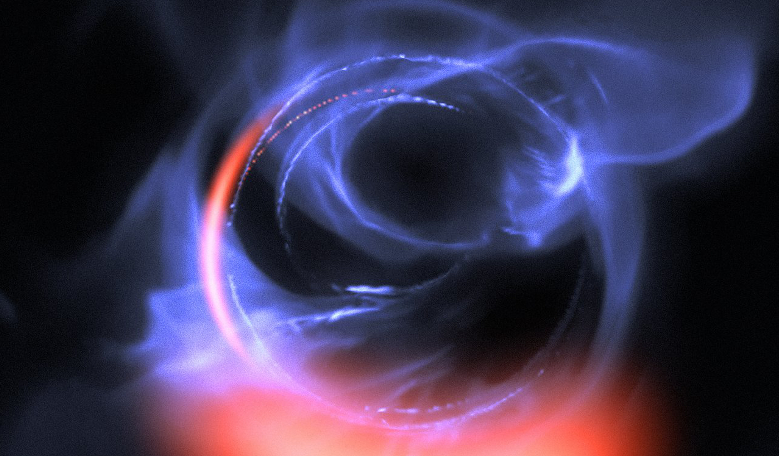By their very nature black holes cannot be seen. These often giant, foreboding spinning vortices of doom suck in matter and light that is never seen again, but before it disappears, this soon to-be-devoured material could be the beacon that gives the black hole away.
Although astronomers have long suspected that a supermassive black hole – called Sagittarius A* (SgrA*) – lurks at the centre of our galaxy, capturing concrete evidence of its existence is tough. But now thanks to new data from ESO’s GRAVITY instrument, a ring of extremely fast moving material has been spotted racing around near its event horizon at about 30 percent the speed of light; this is the most detailed observations yet of material swirling around so close to a black hole at the point of no return.
The material has not yet passed over the event horizon and into the abyss of the black hole, but instead is swirling around Sagittarius A*’s accretion disk – a turbulent, spiralling belt of gas, dust and debris, that pulls in anything that strays too close – and it is shooting out flares of infrared radiation as it does so.
An event horizon is a threshold at which the gravitational pull of a massive object becomes so great, nothing can escape once it crosses over. It is a bizarre region of spacetime, as any object approaching the horizon from an observers point of view on the outside, would appear to slow down and never quite pass through the horizon. The ill-fated object on the other hand would not experience any strange effect and would still disappear into the apparent bottomless depths of the black hole lost forever, as far as we know.
Observations of the flares have only been made only possible due to the impressive light collecting power from four telescopes, that are drawn together in one instrument to create a virtual super-telescope 130 metres in diameter; GRAVITY. This impressive piece of equipment uses lasers and stretchable optic fibres to measure extremely small angles in the sky with extremely high accuracy; angles that are so small, its a bit like picking out a one-euro coin on the surface of the Moon.
"It’s mind-boggling to actually witness material orbiting a massive black hole at 30 percent of the speed of light," marvelled Oliver Pfuhl, a scientist at the Max Planck Institute for Extraterrestrial Physics (MPE). "GRAVITY’s tremendous sensitivity has allowed us to observe the accretion processes in real time in unprecedented detail."
Specifically built to observe very small details on faint objects like the centres of galaxies, GRAVITY, along with another instrument called SINFONI, helped the same team to accurately measure the effects predicted by Einstein’s general relativity on the motion of a star (S2) as it passed through SgrA*’s extreme gravitational field earlier this year.
Like the flares belting out from around SgrA*, S2 was also observed to emit strong infrared emission as it passed within twenty billion kilometres of the black hole.
"We were closely monitoring S2, and of course we always keep an eye on Sagittarius A*," explained Pfuhl. "During our observations, we were lucky enough to notice three bright flares from around the black hole — it was a lucky coincidence!"
The emission from the three flares, which are thought to originate from magnetic interactions in the very hot gas orbiting very close to SgrA*, also exactly matches theoretical predictions for hot spots orbiting close to a black hole with a mass 1.3 trillion times greater than the Earth (or four million solar masses).
This analysis adds further evidence to the long-standing assumption that the black hole residing in the centre of the Milky Way is supermassive. "This always was one of our dream projects but we did not dare to hope that it would become possible so soon,” concluded Reinhard Genzel of the MPE who led the study. “The result is a resounding confirmation of the massive black hole paradigm."











